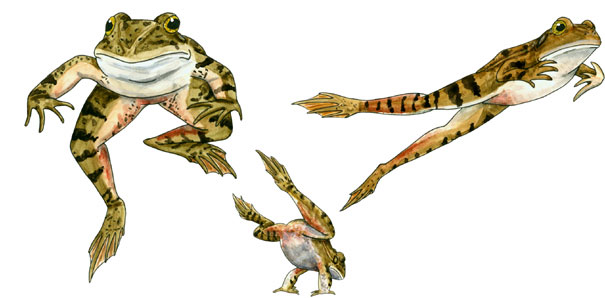As Nina D’Amore shines her flashlight across the dark surface of the water, a pair of glinting yellow eyes reflects back. A closer look confirms her fear–it’s a bullfrog. "I’m going to grab him!" she declares. She wades slowly though the cold pond, the water only inches from the top of her chest waders. Suddenly, D’Amore reaches out, encircling the narrow waist of the Frisbee-sized amphibian with both hands.
"That &#%$@*!" she cries out. She turns around to display her struggling prey, from whose mouth the webbed foot of a smaller frog protrudes. "It ate a red-legged!"
Chaos erupts. D’Amore’s young field assistant valiantly tries to pull the red-legged frog out by its protruding leg. D’Amore protests–they don’t want to hurt the little guy if he’s still alive. She gives the bullfrog to another assistant, who begins to squeeze its stomach. Slowly the red-legged frog emerges backwards, a bizarre breach birth with D’Amore as its anxious midwife. "It’s alive!" she cries as it emerges into the safety of her hands. She checks it over and releases it into the water, where it speeds into the reeds fringing the bank.
Meanwhile, another two small heads are squeezed from the bullfrog, but these red-leggeds aren’t so lucky. The bullfrog must have had a busy night.
Bullfrogs aren’t native to the western United States, but they are threatening a frog that is, the California red-legged. At this pond in Santa Cruz County, south of San Francisco, there used to be hundreds of red-legged frogs. Now there are only a couple dozen.
Bullfrogs are only one of many factors driving red-legged frogs toward extinction. D’Amore, a graduate student at UC Santa Cruz, is also studying how other threats -- agricultural runoff, habitat destruction, and the ravages of disease -- are killing and deforming these fragile animals.
Around the world, hundreds of other amphibian species are also in trouble, and in many cases scientists still don’t know why. Last year, a review of the 5,743 known species of frogs, toads, caecilians and salamanders showed that 32 percent are threatened. As many as 200 species have disappeared from the planet forever.
The Plight of the Red-Legged Frog
Red-legged frogs weren’t always so threatened. In their heyday they ranged from Marin County, north of San Francisco, south to Baja California, Mexico. But in less than 200 years, they have disappeared from more than 70 percent of their historic habitat. Researchers believe only four places within their range have populations of more than 350 adults, and they have all but disappeared from southern California.
Trouble began for the red-legged frog in the mid 1800’s. Massive mining operations dumped mountains of dirt and rock into streams, destroying much of the frog’s habitat. But gastronomic excess truly decimated the red-legged population.
In the late 1800’s and early 1900’s, Californians developed a taste for frog legs. For a while, about 80,000 red-legged frogs a year were harvested from the Central Valley and San Francisco. In 1896, after red-leggeds became rare, the American bullfrog, native to the eastern half of the country, was introduced to fill the demand. The decision proved a serious mistake.
California red-legged frogs are the largest frogs native to the West Coast, but they were no match for bullfrogs. Bullfrogs can weigh as much as a chicken, while the biggest red-legged frogs are smaller than a pigeon — easy pickings for bullfrogs. Rather than allowing the red-legged frogs a chance to recover from the hunters’ depredations, the introduction of bullfrogs only worsened a bad situation. By 1996, red-legged numbers were so low that the U.S. Fish and Wildlife Service classified them a threatened species.
Attack of the Alien Species
The effect of bullfrogs on the red-legged population is one of the major focuses of D’Amore’s research. After many nights spent observing more than 50 ponds in Central California, she is seeing that bullfrogs have a complicated effect on red-legged frogs. "It’s been pretty well documented that bullfrogs eat red-leggeds, but what I’m finding is they’re also drastically changing their behavior and the kind of habitat they’re able to use," D’Amore says. Her field observations confirm earlier studies in which red legged frogs and bullfrogs were raised in enclosures together.
When bullfrogs are around, the red-legged frogs must hide or risk being eaten. But if all the bullfrogs are removed, the native frogs "are actually able to sit out in the floating vegetation, feed efficiently and occupy good habitat rather than being tucked under leaves and leaf litter and mud," D’Amore explained. And so, to protect her shrinking population of threatened frogs, D’Amore has waged a war against the invading species.
Using nets, or often her own hands, D’Amore kills any bullfrogs she can in the ponds she studies. "It’s really hard, and I feel horrible," she says of her grim task, "but I really believe in what I do." So does the California Department of Fish and Game, which supports D’Amore’s efforts.
The slaughter is paying off. At one pond on the property where she works, D’Amore never used to see red-legged frogs. "Then we started bullfrog eradication there," she says. "As bullfrog numbers declined from the hundreds to essentially none, we started to find red-leggeds." There still aren’t many there; her highest count was 17. But "it’s a pretty marked increase from zero," she says.
Catching bullfrogs one-by-one is not feasible for any large area, though. "I don’t think for a second that we’ll be able to get rid of bullfrogs in California," says D’Amore, "but I do think that we can get rid of them in small, isolated pieces of land."
There is another possible way to keep bullfrogs in check. They won’t be able to successfully reproduce if landowners manage their ponds differently, D’Amore says. Bullfrog tadpoles take a full year to develop, while red-legged frogs only need between 3.5 and 7 months. Allowing ponds to evaporate in the summer–after red-leggeds have metamorphosed–would kill an entire generation of bullfrogs at once.
Most of California’s ponds used to dry down like this naturally, D’Amore says. But because many are now artificially filled, they are year-round. To have any hope for threatened amphibians like the red-legged frog, she says, "We need to focus on restoring the natural freshwater habitat that’s still around, and we may need to manage the artificial habitat with a specific eye toward amphibians, like trying to make sure ponds dry down." It’s an uphill battle, though. Even on the land where D’Amore does much of her research, the owner is reluctant to drain any of his ponds.
Whether by catching bullfrogs or advocating new pond management, D’Amore is not the only one battling the hefty invaders. People have introduced American bullfrogs to every continent except Antarctica, "and everywhere they’ve gone, they’ve caused problems," says D’Amore. "Venezuela in particular is mounting a huge campaign to try to get rid of them, poisoning the lakes and streams to try to block the front of the bullfrog invasion." They’re listed as one of the 100 Worst Invasive Alien Species by the World Conservation Union. It’s a dubious honor that places bullfrogs in the league of the kudzu vine, which is engulfing rural areas in the American South, and the brown tree snake, which ate its way through half of Guam’s songbird population.
Bullfrogs aren’t the only invaders decimating amphibian populations. A little to the east and at much higher altitudes than D’Amore’s research ponds, non-native rainbow trout are swallowing the future of the mountain yellow-legged frog, says ecologist Vance Vredenburg. Vredenburg, a post-doctoral fellow at UC Berkeley, has found that the trout feast on tadpoles, preventing yellow-legged frogs from reproducing in over 7,000 lakes that were once their historic habitat. The population of yellow-leggeds has shrunk more than 95 percent since 1950s and 1960s, when the Department of Fish and Game began using airplanes to dump fingerlings into pristine mountain ponds for game fishing. Like the introduction of bullfrogs, it seemed harmless but wrought devastation.
Not your average foot fungus
As it turned out, trout were not the only force decimating yellow-legged frogs. "Just as we were getting a handle on one factor and starting to turn that around," Vredenburg says, "another factor has started to pop its head up." This time the invader is much smaller: the microscopic fungus Batrachochytrium dendrobatidis.
The fungus, part of the chytrid group, starts out life as a little spore that swims around, looking for a host. It seeks kerogen, a tough protein that builds up in the mouthparts of tadpoles or the skin and feet of frogs. There, it hunkers down and starts a tiny factory, producing the next generation of swimming spores. Chytrid doesn’t seem to kill tadpoles, but it is deadly to frogs. "It causes their skin to thicken and start sloughing off like crazy," Vredenburg says. The frogs become weakened and emaciated, and eventually die. At Vredenburg’s research site, "we were finding piles of dead frogs," he says.
Chytrid is by no means limited to the mountain yellow-legged frog. "This new disease has popped up in areas all over the world, and has been associated with the areas of greatest amphibian decline," Vredenburg says–especially Australia and North America. Despite its global reaches, chytrid is a relatively new disease, first identified in 1998. No one knows yet how it spread so quickly, how infectious the spores are, or how hard it is to eliminate.
Some progress is being made, though. Vredenburg used the chytrid outbreak in his study area to research whether the fungus could survive without an amphibian host. For six months he left tadpoles in a lake where the fungus had wiped out all the frogs. When he returned, the tadpoles were still healthy. "It looks like the disease actually goes extinct with its host, the frog," Vredenburg says. The results are promising, suggesting that future generations of frogs might repopulate the lakes.
The disease’s sweeping spread even led researchers to wonder whether they were transmitting it unwittingly. In an ironic twist, were the very people out to save amphibians bringing about their demise as they wandered from pond to pond? That’s unlikely, says Vredenburg. Once field gear dries, chytrid spores probably die. But to be safe, amphibian researchers–including D’Amore’s group–now douse their waders, work surfaces, and tools in bleach between each use.
UNCERTAINTY
D’Amore’s caution is justified–something besides bullfrogs is killing the red-leggeds at one of her research sites. In a reserve at Wilder Ranch State Park, also in Santa Cruz County, D’Amore used to find between 300 and 400 red-legged frogs. But in the seven or eight years since she started surveying, nearly all have disappeared. "In my recent surveys, I’ve seen two individuals there," she says, and there are no bullfrogs around to blame.
The mysterious disappearance could be caused by disease, or perhaps just by the weather, D’Amore says. "Amphibians do definitely cycle. Their numbers will bust and boom depending on rainfall." Another possibility is agricultural runoff. She has found that the red-legged frogs prefer to live in clear, calm waters with low concentrations of the ammonia and nitrate found in fertilizer.
Some also theorize that agricultural runoff causes freakish deformities in amphibians. One main suspect is Atrazine, the most commonly used pesticide in North America. "It’s an example of the dangerous chemicals that our EPA allows to be used," says David Wake, a biologist at the University of California, Berkeley, who first drew attention to the global amphibian decline. "We’re using chemicals that are banned in Europe." Others claim that the deformities are caused by a tiny parasitic flatworm called a trematode.
Whatever the cause, the result is undeniable–an array of freakish frogs with multiple extra or missing toes and limbs. Up to 60 percent of the tree frogs in the Wilder reserve are deformed, and deformities could be affecting the red-legged frogs as well.
Such unforeseen cause-and-effect relationships show up even as D’Amore does her nighttime red-legged surveys. Shortly after rescuing the lucky red-legged from the gourmand bullfrog, D’Amore’s flashlight illuminates a pair of amorous frogs. "Frog sex!" she exclaims excitedly as she pushes toward them through the frigid water. The frogs sit in a quiet stack, male on top. But this love affair will never work. The male is a red-legged frog and his chosen mate is a juvenile bullfrog. "I’ve always heard that that’s another way bullfrogs get in the way of red-legged mating success," D’Amore says. "They’re sort of wasting their oomph." The frogs dart off into the reeds.
The Future
With so much confusion surrounding amphibian declines, hope for the future seems hard to sustain. D’Amore agrees things look grim. "It’s the fate of all species to eventually go extinct, and the red-legged frog will probably go extinct before people do," she says. "At the current rates of development in California, it’s not looking very good."
This fate seems darkly epitomized by the failed attempt to save one of the last red-legged frog populations in Southern California with a captive breeding program. The frogs, located on the Santa Rosa Plateau ecological reserve in Riverside County, had slim prospects even when biologists found them. Only seven red-leggeds were left, six males and one female, says Russell Smith, who led the push for captive breeding at the Los Angeles Zoo. "The one female that I found was on the other side of a busy street, too far to hear the males calling," he says. Before the frogs could be captured, the female disappeared during a particularly stormy El Niño year.
Efforts persisted to find a genetic match for the males, but the only success came from a group of red-legged frogs in Baja California. Before Smith could complete the paperwork required for transporting live frogs from Mexico, the remaining males died. "There hadn’t been reproduction for years," Smith says. "They were steadily just eaten by predators or died off of old age."
This local disappearance is a tiny example of the much larger losses occurring around the planet. In some cases, they span entire groups of species. All 87 of the rainforest frog and toad species from the genera Thorius and Antelopus are endangered. Of those, three-fourths are critically endangered, meaning they are on the brink of extinction. In all, there are about 1,200 endangered or critically endangered amphibian species. "There’s no hope for those that are almost gone," says Berkeley frog researcher Wake. For the other species, it is important to learn as much about them as possible before they begin to disappear, D’Amore says. "Attention needs to be focused on understanding the biology of the species because the tree frog of today is the red-legged of tomorrow."
From the edges of the darkened pond in which D’Amore stands, the chorus of chirping tree frogs proclaims that for now they are still doing well. And then from within the reeds comes a low sound, like a series of grumbling chicken clucks or fingers tapping on the bottom of a child’s beach bucket. D’Amore grins, pleased to hear the love song of a male red-legged frog.
That night she counts 27 red-leggeds, the most she has ever seen in a pond
in that area. It’s good news. But unfortunately, all it will take to
shrink the number once again is a single stray bullfrog. ![]()
ABOUT THE WRITER
 Elise Kleeman
Elise Kleeman
B.S. (geology), California Institute of Technology
ABOUT THE ILLUSTRATOR
 Kathy Jaramillo received her B.S. in Biological Sciences from the
University of California, Riverside, after taking a wide variety of
natural science courses. Her favorite subjects are unusual and
little-known animals, especially mammals. She hopes to work as a freelance
illustrator, with opportunities to observe species in their natural
habitats. Kathy’s preferred technique is detailed watercolor.
Kathy Jaramillo received her B.S. in Biological Sciences from the
University of California, Riverside, after taking a wide variety of
natural science courses. Her favorite subjects are unusual and
little-known animals, especially mammals. She hopes to work as a freelance
illustrator, with opportunities to observe species in their natural
habitats. Kathy’s preferred technique is detailed watercolor.
